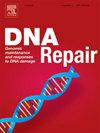甲醛毒性背后的 DNA 病变是什么?
IF 3
3区 生物学
Q2 GENETICS & HEREDITY
引用次数: 0
摘要
甲醛是一种高活性有机化合物。人类可能会接触到外源性甲醛,但甲醛也会作为细胞新陈代谢的副产品在内源性产生。由于甲醛能与 DNA 发生反应,因此被认为是 DNA 损伤的主要内源性来源。然而,细胞中甲醛毒性的基本病变性质仍然非常未知。在此,我们回顾了目前关于甲醛诱导的不同类型核酸病变的知识,并描述了已知的对抗甲醛毒性的修复途径。综合这些知识,我们讨论并推测了甲醛产生的主要病变,这些病变是甲醛天然毒性的基础。本文章由计算机程序翻译,如有差异,请以英文原文为准。
What are the DNA lesions underlying formaldehyde toxicity?
Formaldehyde is a highly reactive organic compound. Humans can be exposed to exogenous sources of formaldehyde, but formaldehyde is also produced endogenously as a byproduct of cellular metabolism. Because formaldehyde can react with DNA, it is considered a major endogenous source of DNA damage. However, the nature of the lesions underlying formaldehyde toxicity in cells remains vastly unknown. Here, we review the current knowledge of the different types of nucleic acid lesions that are induced by formaldehyde and describe the repair pathways known to counteract formaldehyde toxicity. Taking this knowledge together, we discuss and speculate on the predominant lesions generated by formaldehyde, which underly its natural toxicity.
求助全文
通过发布文献求助,成功后即可免费获取论文全文。
去求助
来源期刊

DNA Repair
生物-毒理学
CiteScore
7.60
自引率
5.30%
发文量
91
审稿时长
59 days
期刊介绍:
DNA Repair provides a forum for the comprehensive coverage of DNA repair and cellular responses to DNA damage. The journal publishes original observations on genetic, cellular, biochemical, structural and molecular aspects of DNA repair, mutagenesis, cell cycle regulation, apoptosis and other biological responses in cells exposed to genomic insult, as well as their relationship to human disease.
DNA Repair publishes full-length research articles, brief reports on research, and reviews. The journal welcomes articles describing databases, methods and new technologies supporting research on DNA repair and responses to DNA damage. Letters to the Editor, hot topics and classics in DNA repair, historical reflections, book reviews and meeting reports also will be considered for publication.
 求助内容:
求助内容: 应助结果提醒方式:
应助结果提醒方式:


